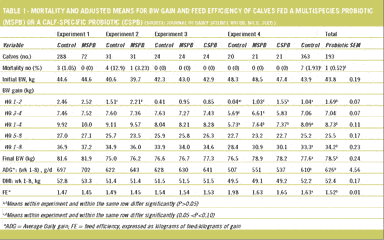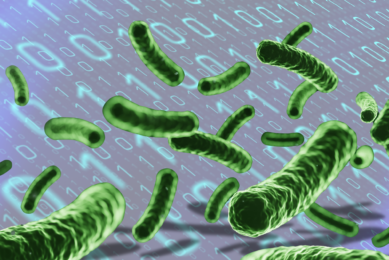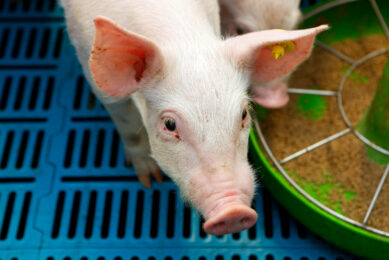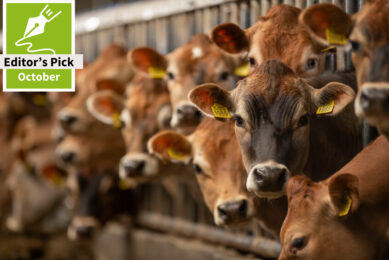Probiotics reduce costly problems in calves

Under current husbandry conditions, veal calves are often affected by diarrhoea and respiratory diseases. this becomes particularly problematic when these animals are exposed to stress and change of diet during the first two weeks of life. Research has shown that by balancing the gut of these animals, with the addition of probiotics to the feed, some of these costly problems could be reduced.
| Diarrhoea is the main cause of morbidity and mortality in the early life of veal calves. In addition, the first peak of respiratory diseases often emerges at four weeks of age. These two diseases cause substantial economic losses due to medication and growth depression. |  |
| Various factors could cause the high incidence of intestinal and respiratory diseases in veal calves. After birth, calves are separated from their mothers. This prevents the calf from acquiring the protective gut microbiota from its mother. Furthermore, at a very young age, the animals are faced with stressful events, like transportation, marketing, dietary changes and exposure to a variety of infectious agents. Consequently, the animals consume less milk and are prone to the loss of the barrier function of the gut and may suffer from impaired immune function. Moreover, the protective potential of the microbial gut microbiota tends to decrease during stressful events, which subsequently increases colonisation of the gut enterobacteriacea. | |
Multispecies versus Multistrain
To prevent the opportunistic pathogenic flora from flourishing, current
practice (in the Netherlands) is to treat calves with prophylactic antibiotics
during the first 5 – 10 days after arrival. However, the antibiotics diminish
not only the activity of the pathogenic microbiota, but also that of the
protective microbiota.
The use of probiotics is promising in establishing a
protective microbiota in veal calves. Various papers have addressed the
anti-diarrhoeal capacities of different pro-biotic strains in calves. Apart from
their positive effects on gastrointestinal infections, probiotics may be used to
prevent non-intestinal infectious conditions, such as respiratory tract
infections. So far, the effect of probiotics, if any, on respiratory health in
veal calves has not been described. To further qualify the health improving
capacity of probiotics in young veal calves, the effect of different kinds of
probiotics on health and growth variables was investigated. Different probiotic
concepts were tested: a multispecies probiotic (MSPB) and a calf specific
multistrain probiotic (CSPB). The MSPB preparation contained 6 commercially
available probiotic strains of various genera; the CSPB preparation used in this
study contained 6 Lactobacillus strains that were originally isolated
from veal calf digesta and faeces. It was reasoned that the combination of
genera-specific probiotic properties should make the MSPB preparation superior
to the traditional monostrain probiotics. It was also hypothesised that the calf
specificity of CSPB would enhance the ability of the probiotic product to
colonise in the host animal. Because successful colonisation is one of the
prerequisites for a probiotic to exert its beneficial activity, it could be
suggested that the CSPB should have a greater effect than the MSPB. Furthermore,
it should be noted that fresh fermented probiotic cultures were used instead of
the common (and more expensive) freeze-dried preparations. The study consisted
of four experiments (Table 1
). In the first two experiments, only the MSPB preparation was tested.
The probiotics were administered during the first 14 days after arrival of the
calves. In the last two experiments, both the MSPB and CSPB preparations were
tested and the period of probiotic administration was extended to 8 weeks.
|
Increase in growth
Mortality and growth performance are presented in
Table 1 . There was no
significant effect of probiotic treatment on mortality, growth and FE (feed
efficiency) in experiment 1. In experiment 2, there was a lower Average Daily
Gain (ADG) from 1 – 8 wk compared with experiment 1. No significant difference
occurred regarding mortality, although 4 animals in the control group and 1
animal in the MSPB group died. Treatment with MSPB significantly enhanced growth
from 1 – 2 weeks; BW (body weight) gain was 46% higher than in the control
animals. This growth-promoting effect of MSPB was still noticeable at week 8;
however, it was not statistically significant (NS). No mortality occurred in
experiment 3. Calves fed MSPB or CSPB numerically increased BW gain during the
first 2 weeks. The probiotic-induced increase of BW gain was not statistically
significant, although a significant improvement of FE for 1 – 2 weeks was
observed (data not shown). No significant differences regarding BW gain and FE
were seen for week 1 – 8. There was a carryover effect of probiotic treatment in
that it reduced digestion problems during the last phase of the 26-week
fattening period and lowered the FE from week 20 – 27 (data not shown). The
result was a 4.0kg and 4.1kg higher carcass weight for the CSPB- and
MSPB-treated animals, respectively. The increase in carcass weight was not
statistically significant. There was no mortality in experiment 4. BW gain was
low compared with that found in experiments 1, 2 and 3. Both probiotic
treatments markedly enhanced BW gain. The growth-promoting effect of CSPB was
statistically significant for week 1 – 2 and 1 – 4, whereas MSPB treatment
significantly increased BW gain for week 1 – 4 and 3 – 4. The growth-promoting
effect was still present for week 1 – 8 (NS). Feed efficiency over the 8-week
period numerically decreased after treatment with MSPB or CSPB (-18% and -17%;
NS). When all the data was pooled, probiotic treatment was associated with
significantly enhanced growth during the first 2 weeks and in the periods 1 – 4
and 1 – 8 weeks of the starter phase. BW at 8 weeks was significantly higher
after probiotic treatment. Average daily gain and FE from week 1 – 8 was
significantly improved after feeding probiotics (+2.6% and -6.7%). Furthermore,
probiotic treatment tended to lower mortality.
Effect on diarrhoea incidence and
duration
In experiment 2 and 4, a distinction was made between mild and severe
diarrhoea. There was a low incidence of diarrhoea in experiment 1 compared with
the other experiments. Treatment with MSPB caused a reduction in average
duration of diarrheic episodes (NS; data not shown). In experiment 2, the number
of days with mild diarrhoea was high. Treatment with MSPB resulted in a
non-significant increase. In experiment 3, treatment with either MSPB or CSPB
reduced the incidence of diarrhoea. The CSPB, unlike MSPB, diminished the
duration of diarrhoea. In experiment 4, CSPB treatment successfully suppressed
mild diarrhoea compared with the calves treated with MSPB and the control
calves. Administration of MSPB had no significant influence on mild diarrhoea.
Both MSPB and CSPB treatment lowered the incidence of severe diarrhoea (NS).
Treatment with CSPB significantly lowered the incidence and duration of
diarrhoea (-50% and -58%), irrespective of its nature. In experiments 3 and 4,
faecal samples were taken to enumerate the number of faecal lactobacilli and
coliforms on day 5, 12 and 50 after arrival of the calves. The numbers were
generally higher in experiment 3 than in experiment 4. There was no effect of
either probiotic on the number of faecal lactobacilli. Coliform concentrations
in the faeces tended to be decreased with probiotic treatment. Treatment with
CSPB reduced the average number of coliforms on day 5 by 14% and 57% (P <
0.05) in experiment 3 and 4, respectively. Only in experiment 4 did the CSPB
treatment significantly reduce the average faecal coliform population. Treatment
with MSPB did not affect coliforms in experiment 3; however, a small,
non-significant reduction was seen in experiment 4 on day 5 and 12.
Digestive and respiratory diseases
The lowest percentage of animals that needed therapeutic treatment of
digestive diseases, and for all infections combined, was seen in experiment 1.
Treatment with MSPB resulted in a lower percentage of animals being treated for
digestive diseases and a lower number of treatments (NS). There was a high
incidence of digestive and respiratory diseases in experiment 2. Treatment with
MSPB did not elicit a clear influence on treatments for digestive or respiratory
diseases. In experiment 3, the control animals had a high incidence of
gastrointestinal infections and a low incidence of respiratory diseases.
Treatment with MSPB successfully reduced the percentage of animals suffering
from digestive diseases and the number of treatments needed (P < 0.05).
Overall, MSPB significantly reduced the percentage of animals in need of
therapeutic treatment for any reason, as well as the average amount of
treatments needed. In experiment 4, the incidence of digestive diseases was
moderate. Both MSPB and CSPB numerically lowered the percentage of animals
treated and the average number of treatments needed. In experiment 4, both MSPB
and CSPB significantly reduced the incidence of respiratory disease and its
severity as expressed by the number of total treatments needed per affected
animal (data not shown). Treatment with MSPB or CSPB significantly reduced the
percentage of animals in need of therapeutic treatment of any cause and reduced
the total number of treatments needed (-72% and -57%, respectively).
Effect on GHS
During the experiments, the General Health Score (GHS) of all the calves was
calculated. A low GHS may be associated with high infection pressure and could
cause diarrhoea, respiratory diseases and other infectious diseases, as well as
high mortality. Health was significantly compromised in experiment 4 compared
with calves in the other experiments. In experiment 1, the GHS was relatively
high indicating a low infection pressure. Excluding experiment 1, probiotics
numerically raised the GHS. In experiment 2 and 3, treatment with either
probiotic improved the GHS to a similar extent (NS). Animals in experiment 4
showed the lowest GHS. In this situation, treatment with either probiotic
resulted in a marked improvement of the GHS (P < 0.01). When all the data was
pooled, probiotic treatment was found to be associated with a significantly
improved GHS. It could be suggested that the stimulatory effect of probiotic
treatment on growth depends on the baseline GHS. Indeed, the GHS of control
calves and the MSPB-induced increase in ADG during week 1 – 8 were negatively
related when the data of the 4 experiments was pooled. Thus, the higher the GHS
of control calves, the lower the MSPB-induced increase in weight gain.
Conclusion
It is clear from this study in 1-week-old veal calves that administration of
probiotics may increase BW gain during the first 2 weeks of use. The
probiotic-induced increase in BW gain for the period of 1 – 8 weeks was greater
when the calves were considered less healthy. Thus, the positive effect of
probiotics on growth performance of calves may only be present when their health
status is compromised. BW and feed efficiency at 8 weeks after arrival were
significantly improved by probiotic treatment. Probiotic treatment reduced the
incidence of diarrhoea and the average number of diarrheic days. Mortality
tended to be lower after feeding a milk replacer with probiotics. Although there
were differences in outcomes between experiments, it can be concluded that the
supply of probiotics reduced the necessity of antibiotic treatments against
digestive and respiratory diseases. Further experiments are required to study
underlying mechanisms and to evaluate the potential of probiotics to improve
respiratory health in veal calf production.
About the
Author
Harro Timmerman graduated in animal
sciences from Wageningen University in 1999. in 2000, he began a PhD at Winclove
Bio Industries BV (www.winclove.nl) on the health promoting effects of
probiotics in livestock. this study has been carried out in cooperation with
Schothorst feed research, the faculty of animal nutrition at Utrecht University,
the laboratory of food microbiology at Wageningen University and several feed
companies. In 2006, Timmerman successfully completed his PhD thesis:
Multispecies probiotics – composition and functionality.
Source: Feed Mix magazine Volume 15 nr.1












